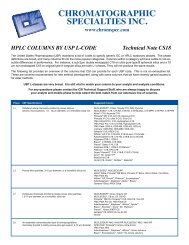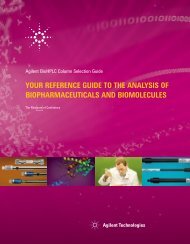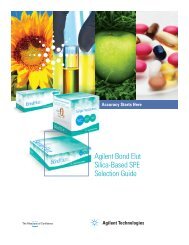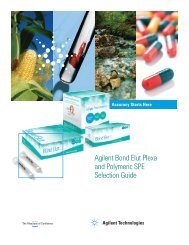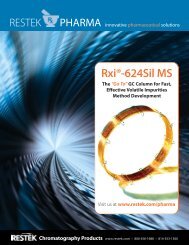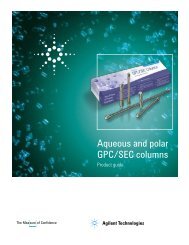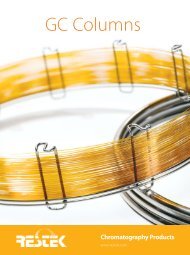Optimizing the Analysis of Volatile Organic Compounds
Optimizing the Analysis of Volatile Organic Compounds
Optimizing the Analysis of Volatile Organic Compounds
Create successful ePaper yourself
Turn your PDF publications into a flip-book with our unique Google optimized e-Paper software.
10<br />
www.restekcorp.com<br />
Valves<br />
The purge and desorb flows are controlled by an automated switching valve (Figure 6). The<br />
valve is contained in a heated compartment to prevent sample condensation inside. By rotating<br />
<strong>the</strong> valve, <strong>the</strong> purge and desorb flow paths can be changed during <strong>the</strong> purge and trap<br />
sequence (Figure 7).<br />
Figure 6.<br />
The 6-port automated switching valve (V) controls purge and desorb flow rates.<br />
heated transfer line to GC<br />
(4) 0.32mm ID fused<br />
silica transfer line<br />
(protected within<br />
0.53mm ID<br />
Silcosteel ® line)<br />
(3) desorb/carrier gas<br />
(2) from outlet end <strong>of</strong> trap<br />
Tekmar 3100 in<br />
Desorb Mode<br />
Figure 7.<br />
The flow paths for purging and desorbing are determined by <strong>the</strong> valve position.<br />
purge<br />
purge gas in<br />
gas in<br />
GC column<br />
gas in<br />
5 6<br />
4 1<br />
3 2<br />
vent<br />
Valve positioned to purge sample onto trap.<br />
trap<br />
Adsorbent Materials and Traps<br />
x<br />
(1) vent<br />
GC column<br />
gas in<br />
5 6<br />
4 1<br />
3 2<br />
(5) from<br />
inlet end<br />
<strong>of</strong> trap<br />
(6) purge<br />
trap<br />
backflush<br />
Valve position changed to<br />
desorb sample from trap<br />
and into capillary column.<br />
Adsorbent materials are used to trap <strong>the</strong> VOCs that have been purged from <strong>the</strong> sample. The<br />
adsorbent must be able to retain compounds during <strong>the</strong> entire purging sequence and <strong>the</strong>n<br />
rapidly release <strong>the</strong>m during <strong>the</strong> desorption step. Each adsorbent has a unique trapping capability<br />
for a specific class or classes <strong>of</strong> compounds. Therefore, a trap may have several different<br />
beds <strong>of</strong> adsorbents. The weakest adsorbent material is placed at <strong>the</strong> inlet end <strong>of</strong> <strong>the</strong> trap,<br />
<strong>the</strong>n <strong>the</strong> next strongest adsorbent, and so on. The more volatile compounds pass through <strong>the</strong><br />
weaker adsorbents and are retained by <strong>the</strong> stronger adsorbents, while <strong>the</strong> less volatile compounds<br />
are retained on <strong>the</strong> weaker adsorbents and never reach <strong>the</strong> stronger adsorbents (from<br />
which <strong>the</strong>y would be difficult to desorb). Once <strong>the</strong> compounds are collected, <strong>the</strong> trap is rapidly<br />
heated and backflushed with carrier gas to drive <strong>the</strong> sample components into <strong>the</strong> GC<br />
system. Ideally, <strong>the</strong> adsorbents in <strong>the</strong> trap retain polar and non-polar analytes without retaining<br />
water or methanol, efficiently release <strong>the</strong> trapped compounds onto <strong>the</strong> analytical column,<br />
and withstand <strong>the</strong> temperatures required to desorb (i.e., “bake <strong>of</strong>f”) <strong>the</strong> higher molecular<br />
weight contaminants. A list <strong>of</strong> common traps used in purge and trap concentration can help<br />
you choose <strong>the</strong> best one for your application (Table II, page 13).<br />
V<br />
vent





